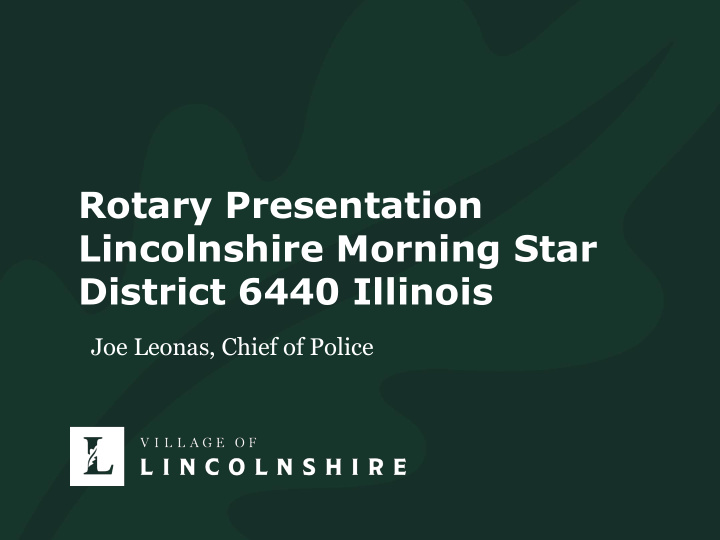



Rotary Presentation Lincolnshire Morning Star District 6440 Illinois Joe Leonas, Chief of Police
Agenda Introduction • Concept of community trust • Guardian vs Warrior philosophy • Campaign Zero, #8CANTWAIT, and the Lincolnshire • Police Department
My background I started my career as a police officer in 1990 at the • Bartlett Police Department I began serving as Chief of Police in Lincolnshire in • 2016 When I arrived at Lincolnshire I wanted to know 3 • things: Do our officers know how to do their jobs? • Do our policies support the right actions? • Does our culture support both? •
A few things before we start… I do not have all the answers • We recruit from the human race and we try to treat • the “human condition” Sometimes people can make mistakes, and the police • can make mistakes too Many people oversimplify and overgeneralize • important issues Our jobs are complicated and require a wide range of • options Police officers have discretion to take action or not, • and there very few absolutes
How did we get here?
According to the Illinois Chiefs of Police Association: Since August 2014, there have been several intense • rounds of national media coverage centering on a small number of high-profile and contentious officer- involved use of force incidents. Such coverage has impacted community perceptions • of the police and impacted the overall police- community relationship. Relative to the importance of the police-community • relationship, the following 4 assumptions are widely held…
Illinois Chiefs of Police Association 1. Relationships A positive police-community relationship is a critical factor in • whether a policing agency can effectively meet its mission within the community. 2. Perception When large segments of the community perceive that the • police are not engaged in legitimate policing activities, the police-community relationship is weakened. 3. Reluctance When the police-community relationship is contentious, • police officers are more reluctant to engage in officer- initiated policing activities. 4. Inside & out Policing executives must be proactive in fostering and • maintaining a positive relationship with the community, both externally and internally within their agencies.
“Guardians vs. Warriors” Susan L. Rahr, Sheriff of King County, Washington (2005 to 2012) Soldier Police
#8CANTWAIT 1. Ban chokeholds and strangleholds. Already prohibited • 2. Require officers to de-escalate situations, where possible, by communicating with subjects, maintaining distance, and otherwise eliminating the need to use force. Already in policy • 3. Require officers to give a verbal warning in all situations before using deadly force. Not in policy to require a warning • 4. Require officers to exhaust all other alternatives, including non-force and less lethal force options, prior to resorting to deadly force. An officer may use the amount of force which he/she reasonably believes to be • necessary to effect an arrest and may use any force which he/she reasonably believes to be necessary to defend him/herself or another from bodily harm while making an arrest. 5. Require officers to intervene and stop excessive force used by other officers and report these incidents immediately to a supervisor. Already in policy •
#8CANTWAIT • Ban officers from shooting at moving vehicles in all cases. • Already in policy, but does not ban in all cases. • An officer should only discharge a firearm at a moving vehicle or its occupants when the officer reasonably believes there are no other reasonable means available to avert the threat of the vehicle, or if deadly force is directed at Police officers and rescue workers stand near a van that the officer or others. struck a crowd leaving a fireworks display in the French Riviera town of Nice on July 14, 2016.
#8CANTWAIT 7. Establish a Force Continuum that restricts the most severe types of force to the most extreme situations and creates clear policy restrictions on the use of each police weapon and tactic. An officer may use deadly force only when they reasonably believe • that deadly force is necessary to prevent death or great bodily harm to themselves or other people, or when they reasonably believe that: Such force is necessary to prevent an arrest from being defeated • by resistance or escape and, the people to be arrested have committed or attempted • a forcible felony that involves the infliction or threatened infliction of great bodily harm, or are attempting to escape by use of a deadly weapon • or otherwise have indicated that they will endanger human • life or inflict great bodily harm unless arrested without delay. A verbal warning should precede the use of deadly force, when • feasible. Warning shots are prohibited. •
#8CANTWAIT 8. Require officers to report each time they use force or threaten to use force against civilians. Any use of force by a member of the Lincolnshire police • department shall be documented promptly, completely and accurately in an appropriate report, depending on the nature of the incident. The officer shall articulate the factors perceived and • why he/she believed the use of force was reasonable under the circumstances. This includes whenever any weapon, including a • firearm is pointed at someone.
Use of Force Continuum • Force is ugly • Not judged right/wrong • Reasonableness Standard – (Graham v. Connor, 1989) • Continuum vs. Reasonableness • Process vs outcome
Recommend
More recommend